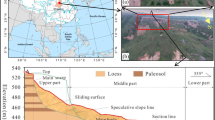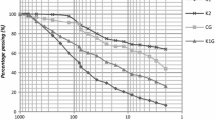Abstract
The internal friction angle of loess joint is measured by means of direct shear test. The results show that the relationship between internal friction angle and moisture content is revealed to be a parabola one. The internal friction angle has an extremum when the moisture content reaches a certain value. This moisture content is called the limit moisture content. The internal friction angle is also related to the dry density of loess, but it is not remarkable. The matric suction of the tested loess is tested as well. Analysis bases on tested data shows that, when the moisture content is greater than the limit moisture content, the matric suction and shear strength decrease with the increase in moisture content of loess. However, when the moisture content is lower than the limit moisture content, the current understanding on the relationship between water content and matrix suction is not appropriate, and results show that the matric suction and shear strength increase with the increase in loess moisture content.

Similar content being viewed by others
References
Youcef L., Ratiba M., Mohammed T.B., Mohammed D., Abdelouahed K.: The manufacture of raw brick from the Saharan sand-based mortar of Ouargla (located in the Septentrional Sahara, Algeria) for use in arid regions. Arab. J. Sci. Eng. 37(8), 2149–2161 (2012)
Mostafa A.B., Thamer A.M., Abdul H.G., Mohd A.M.S.: Validation of selected models for evaporation estimation from reservoirs located in arid and semi-arid regions. Arab. J. Sci. Eng. 37(3), 521–534 (2012)
Saeed A., Attaullah S.: Evaluation of shear strength of high strength concrete corbels using strut and tie model (STM). Arab. J. Sci. Eng. 34(1B), 27–35 (2009)
Mahmood N.: The use of friction-transfer methods inprediction of in-situ strength of concrete. Arab. J. Sci. Eng. 33(2B), 337–354 (2008)
Harun T., Ahmet C., IIyas S.: An experimental investigation of bond and compressive strength of concrete with mineral admixtures at high temperatures. Arab. J. Sci. Eng. 33(2B), 443–450 (2008)
Wang J.M., Ni Y.L.: A study on structural joints in loess and its practical application. J. Eng. Geol. 2(4), 31–42 (1994) (in Chinese)
Zhang M.H., Xie Y.L., Liu B.J.: Analysis of shear strength characteristics of loess during moistening process. Rock Soil Mech. 27(7), 1195–1200 (2006) (in Chinese)
Dang J.Q., Li J.: The structural strength and shear strength of unsaturated loess. J. Hydra. Eng. 7(7), 79–83 (2001) (in Chinese)
Lu Q.Z., Peng J.B.: Characteristics of structural planes of loess mass in loess plateau of China and its hazard effect. J. Xi’an Univ. Sci. Technol. 26(4), 446–450 (2006) (in Chinese)
Jiang H.B., Su S.R., Ni W.K., Guo Y.M.: Effects of loess joints on stability of highway slopes in northern Shanxi. J. Eng. Geol. 14(3), 360–364 (2006) (in Chinese)
Li B.X., Niu Y.H., Miao T.D.: Physico-mechanical characteristics of Malan loess in Lanzhou region. Rock Soil Mech. 28(6), 1077–1082 (2007) (in Chinese)
Ma J., Chen S.X., Yu F., Feng M.G.: Experimental research on crack evolution process in fissured clay. Rock Soil Mech. 28(10), 2203–2208 (2007) (in Chinese)
Hu X.W., Li Q.F., Zhao Z.S. et al.: Mechanical properties of fissured clay. Chin. J. Geotech. Eng. 16(4), 81–88 (1994) (in Chinese)
Jiang J.P., Zhang Y.S., Luo G.Y.: Macroscopical structure plane and its influence on failure of soil mass. Rock Soil Mech. 23(4), 482–485 (2002) (in Chinese)
Yao H.L., Zheng S.H., Chen S.Y.: Analysis of slope stability of expansive soils considering cracks and infiltration of rain. Chin. J. Geotech. Eng. 23(5), 606–609 (2001) (in Chinese)
Zheng J.G., Zhang S.M.: The strength characteristics of collapsible loess during moistening process. Hydrogeol. Eng. Geol. 2, 6–10 (1989) (in Chinese)
Qian J.H., Yin Z.Z.: Principle and Calculation for Geotechnical Engineering. China Water Power Press, Beijing (1996) (in Chinese)
Fredlund D.G., Rahardjo H.: Soil Mechanics for Unsaturated Soils. Wiley, New York (1993)
Author information
Authors and Affiliations
Corresponding author
Rights and permissions
About this article
Cite this article
Luo, Y., Wang, T.H., Liu, X.J. et al. Laboratory Study on Shear Strength of Loess Joint. Arab J Sci Eng 39, 7549–7554 (2014). https://doi.org/10.1007/s13369-014-1318-x
Received:
Accepted:
Published:
Issue Date:
DOI: https://doi.org/10.1007/s13369-014-1318-x




